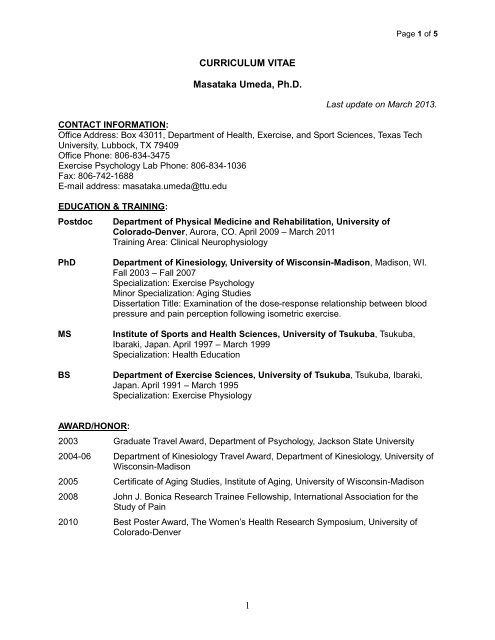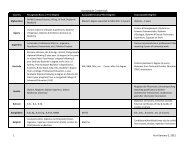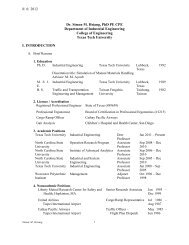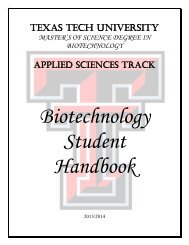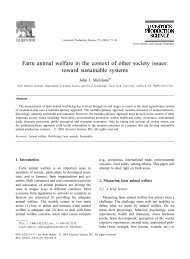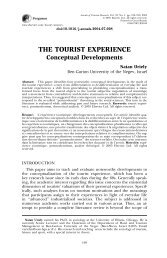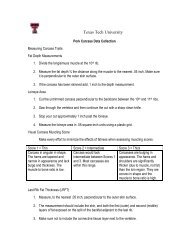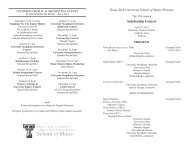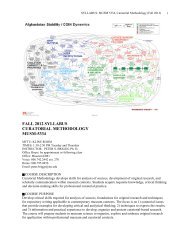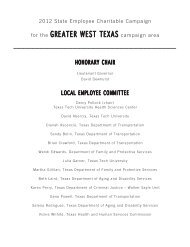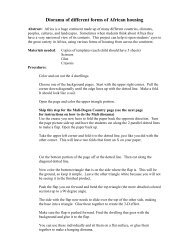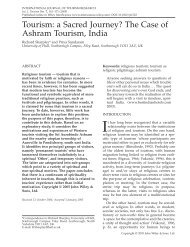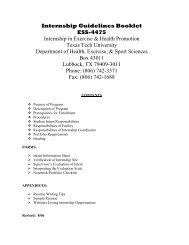CURRICULUM VITAE - Texas Tech University
CURRICULUM VITAE - Texas Tech University
CURRICULUM VITAE - Texas Tech University
You also want an ePaper? Increase the reach of your titles
YUMPU automatically turns print PDFs into web optimized ePapers that Google loves.
Page 1 of 5<br />
<strong>CURRICULUM</strong> <strong>VITAE</strong><br />
Masataka Umeda, Ph.D.<br />
Last update on March 2013.<br />
CONTACT INFORMATION:<br />
Office Address: Box 43011, Department of Health, Exercise, and Sport Sciences, <strong>Texas</strong> <strong>Tech</strong><br />
<strong>University</strong>, Lubbock, TX 79409<br />
Office Phone: 806-834-3475<br />
Exercise Psychology Lab Phone: 806-834-1036<br />
Fax: 806-742-1688<br />
E-mail address: masataka.umeda@ttu.edu<br />
EDUCATION & TRAINING:<br />
Postdoc<br />
Department of Physical Medicine and Rehabilitation, <strong>University</strong> of<br />
Colorado-Denver, Aurora, CO. April 2009 – March 2011<br />
Training Area: Clinical Neurophysiology<br />
PhD<br />
MS<br />
BS<br />
Department of Kinesiology, <strong>University</strong> of Wisconsin-Madison, Madison, WI.<br />
Fall 2003 – Fall 2007<br />
Specialization: Exercise Psychology<br />
Minor Specialization: Aging Studies<br />
Dissertation Title: Examination of the dose-response relationship between blood<br />
pressure and pain perception following isometric exercise.<br />
Institute of Sports and Health Sciences, <strong>University</strong> of Tsukuba, Tsukuba,<br />
Ibaraki, Japan. April 1997 – March 1999<br />
Specialization: Health Education<br />
Department of Exercise Sciences, <strong>University</strong> of Tsukuba, Tsukuba, Ibaraki,<br />
Japan. April 1991 – March 1995<br />
Specialization: Exercise Physiology<br />
AWARD/HONOR:<br />
2003<br />
2004-06<br />
2005<br />
2008<br />
2010<br />
Graduate Travel Award, Department of Psychology, Jackson State <strong>University</strong><br />
Department of Kinesiology Travel Award, Department of Kinesiology, <strong>University</strong> of<br />
Wisconsin-Madison<br />
Certificate of Aging Studies, Institute of Aging, <strong>University</strong> of Wisconsin-Madison<br />
John J. Bonica Research Trainee Fellowship, International Association for the<br />
Study of Pain<br />
Best Poster Award, The Women’s Health Research Symposium, <strong>University</strong> of<br />
Colorado-Denver<br />
1
Page 2 of 5<br />
PROFESSIONAL EXPERIENCES:<br />
Assistant Professor:<br />
Department of Health, Exercise, and Sport Sciences, <strong>Texas</strong> <strong>Tech</strong> <strong>University</strong> (Fall 2012 –<br />
Present)<br />
<br />
<br />
Teaching Responsibility: ESS4363 Principles and Theories of Exercise Psychology<br />
Primary research interest: Psychophysiological investigation of the relationship between<br />
physical activity and pain in individuals with and without chronic pain conditions (e.g.,<br />
fibromyalgia)<br />
Postdoctoral Fellow:<br />
Department of Physical Medicine and Rehabilitation, <strong>University</strong> of Colorado-Denver (April<br />
2009 – March 2011).<br />
Graduate Research Assistant:<br />
<br />
Mississippi Urban Research Center, Program Evaluation, Jackson State <strong>University</strong> (Fall<br />
2000 – Spring 2001).<br />
Department of Psychology, Jackson State <strong>University</strong> (Fall 2001 – Spring 2003).<br />
Department of Kinesiology, <strong>University</strong> of Wisconsin-Madison (Fall 2003 – Fall 2007).<br />
Graduate Teaching Assistant:<br />
PSY200 General Psychology, Department of Psychology, Jackson State <strong>University</strong> (Fall<br />
2002).<br />
PE100 Exercise, Nutrition, and Health, Department of Kinesiology, <strong>University</strong> of<br />
Wisconsin-Madison (Fall 2003 – Spring 2005).<br />
KINES350 Introduction to Exercise Psychology, Department of Kinesiology, <strong>University</strong> of<br />
Wisconsin-Madison (Fall 2003 – Spring 2005).<br />
Other Relevant Experience:<br />
Personal Trainer at the Do Sport Plaza, Tokyo, Japan (April 1995 – June 1996).<br />
PROFESSIONAL AFFILIATIONS:<br />
2012-Present American College of Sports Medicine, Member<br />
2011-Present American Pain Society, Member<br />
2013-Present Society of Behavioral Medicine, Member<br />
2013-Present Laura W. Bush Institute of Women’s Health, Member<br />
PROFESSIONAL SERVICE:<br />
Graduate Project Committee<br />
Zahra Mizani – Exercise and Sport Psychology (Fall 2012)<br />
Manuscript Reviewer:<br />
Biological Psychology (2011)<br />
Disability and Rehabilitation (2013)<br />
RESEARCH ACTIVITIES:<br />
Current Projects:<br />
1. The relationship between psychophysical responses to laboratory exercise and free-living<br />
physical activity in patients with fibromyalgia.<br />
Role: PI<br />
Status: Active<br />
2
Page 3 of 5<br />
Aim: To understand potential psychophysical correlates of laboratory exercise with daily<br />
physical activity among patients with fibromyalgia<br />
2. The influence of physical activity levels on central pain modulation in healthy young adults.<br />
Role: PI<br />
Status: active<br />
Aim: To understand the potential benefits of regular physical activity on central pain<br />
modulation in healthy young adults<br />
Publications in Peer-reviewed Journals:<br />
1. Cassisi, J.E., Umeda, M., Deisinger, J.A., Sheffer, C., Lofland, K.R., & Jackson, C. (2004).<br />
Differences in the factor structure of pain descriptors in African Americans and European<br />
Americans with chronic pain. Cultural Diversity and Ethnic Minority Psychology, 10 (1), 90-94.<br />
IF = 1.356.<br />
2. Koltyn, K.F. & Umeda, M. (2006). Exercise, hypoalgesia, and blood pressure. Sports<br />
Medicine, 36 (3), 207-14. IF = 5.155.<br />
3. Koltyn, K.F. & Umeda, M. (2007). Contralateral attenuation of pain following short duration<br />
submaximal isometric exercise. The Journal of Pain, 8 (11), 887-892. IF = 4.926.<br />
4. Umeda, M., Newcomb, L.W., & Koltyn, K.F. (2009). Influence of blood pressure elevations by<br />
isometric exercise on pain perception in women. International Journal of Psychophysiology,<br />
74 (1), 45-52. IF = 2.144.<br />
5. Umeda, M., Newcomb, L.W., Ellingson, L.E., & Koltyn, K.F. (2010). Examination of the<br />
dose-response relationship between pain perception and blood pressure induced by<br />
isometric exercise. Biological Psychology, 85 (1), 90-96. IF = 3.225.<br />
6. Umeda, M., Corbin, L. W., & Maluf, K. S. Preliminary investigation of absent nociceptive<br />
flexion reflex responses among more symptomatic women with fibromyalgia syndrome<br />
(accepted for publication in Rheumatology International). IF = 1.885.<br />
IF= 2011 Journal Impact factor<br />
Manuscript in Preparation for Submission:<br />
1. Umeda, M., Corbin, L. W., & Maluf, K.S. Pain mediates the association between physical<br />
activity and the impact of fibromyalgia on daily function.<br />
Published Abstracts:<br />
1. Umeda, M., Deisinger, J.A., Sheffer, C., Lofland, K.R., & Cassisi, J.E. (2003). Differences in<br />
the factor structure of pain descriptions in a racially diverse sample of chronic pain patients.<br />
The Journal of Pain, 4 (2), Supplement 1, 4.<br />
2. Umeda, M., Cassisi, J.E., Koltyn, K.F., & Shea, D.T. (2004). Influence of response bias on<br />
self-reported pain in response to the cold pressor test in college men and women. The<br />
Journal of Pain, 5 (3), Supplement 1, 133.<br />
3. Koltyn, K.F., Umeda, M., & Dietrich, P.M. (2004). Influence of parental history of hypertension<br />
on cardiovascular responses to a noxious stimulus. The Journal of Pain, 5 (3), Supplement 1,<br />
35.<br />
4. Koltyn, K.F., Flood, S., & Umeda, M. (2005). Assessing pain associated with activities of daily<br />
living in older adults. The Journal of Pain, 6 (3), Supplement 1, S70.<br />
5. Umeda, M. & Koltyn, K.F. (2005). Influence of aerobic exercise intensity on alterations in pain<br />
perception in women. Medicine and Science in Sports and Exercise, 37 (5), Supplement,<br />
S332.<br />
6. Umeda, M., Newcomb, L.W., & Koltyn, K.F. (2006). Influence of blood pressure elevations<br />
following isometric exercise on pain perception in women. The Journal of Pain, 7 (4),<br />
Supplement 2, S19.<br />
3
Page 4 of 5<br />
7. Koltyn, K.F., Umeda, M., Flood, S., & Hoeger-Bement, M. (2007). Use of coping strategies by<br />
older adults with chronic pain. The Journal of Pain, 8 (4) Supplement 1, S57.<br />
8. Umeda, M., Newcomb, L.W., Ellingson, L.E., & Koltyn, K.F. (2008). Examination of the<br />
dose-response relationship between blood pressure and pain perception following isometric<br />
exercise. Medicine and Science in Sports and Exercise, 40 (5), Supplement, S117.<br />
9. Umeda, M., Nagel, C. A., Balter, J. E., Nofsinger, M. L., Corbin, L. W., & Maluf, K. S. (2010).<br />
The effects of isometric handgrip exercise on pain perception and nociceptive reflexes in<br />
women with and without fibromyalgia. Included in CD of abstracts for the 13 th World Congress<br />
on Pain.<br />
10. Umeda, M., Corbin, L. W., & Maluf, K. S. (2011). The role of pain in mediating the association<br />
between leisure time physical activity and impact of fibromyalgia on daily function. <strong>University</strong><br />
of Colorado-Denver Postdoctoral Research Day.<br />
Poster Presentations:<br />
1. Umeda, M., Deisinger, J.A., Sheffer, C., Lofland, K.R., & Cassisi, J.E. (2003). Differences in<br />
the factor structure of pain descriptions in a racially diverse sample of chronic pain patients.<br />
Annual scientific meeting of the American Pain Society, Chicago, IL.<br />
2. Umeda, M., Deisinger, J.A., Sheffer, C., Lofland, K.R., & Cassisi, J.E. (2003). Differences in<br />
the factor structure of pain descriptors by race. Annual scientific meeting of the Southeastern<br />
Psychological Association, New Orleans, LA.<br />
3. Umeda, M., Cassisi, J.E., Koltyn, K.F., & Shea, D.T. (2004). Influence of response bias on<br />
self-reported pain in response to the cold pressor test in college men and women. The joint<br />
scientific meeting of the American and Canadian Pain Society, Vancouver, BC, Canada.<br />
4. Umeda, M. & Koltyn, K.F. (2005). Influence of aerobic exercise intensity on alterations in pain<br />
perception in women. Annual scientific meeting of the American College of Sports Medicine,<br />
Nashville, TN.<br />
5. Umeda, M., Newcomb, L.W., & Koltyn, K.F. (2006). Influence of blood pressure elevations<br />
following isometric exercise on pain perception in women. Annual scientific meeting of the<br />
American Pain Society, San Antonio, TX.<br />
6. Umeda, M., Nagel, C. A., Balter, J. E., Nofsinger, M. L., Corbin, L. W., & Maluf, K. S. (2010).<br />
The effects of isometric handgrip exercise on pain perception and nociceptive reflexes in<br />
women with and without fibromyalgia. Biannual scientific meeting of the International<br />
Association for the Study of Pain, Montreal, Quebec, Canada.<br />
7. Umeda, M., Nagel, C. A., Balter, J. E., Nofsinger, M. L., Corbin, L. W., & Maluf, K. S. (2010).<br />
The effects of isometric handgrip exercise on pain perception and nociceptive reflexes in<br />
women with and without fibromyalgia. Best Poster Award. Annual scientific meeting of the<br />
Center for Women’s Health Research, <strong>University</strong> of Colorado-Denver, Aurora, CO.<br />
8. Umeda, M., Corbin, L. W., & Maluf, K. S. (2011). The role of pain in mediating the association<br />
between leisure time physical activity and impact of fibromyalgia on daily function. <strong>University</strong><br />
of Colorado-Denver Postdoctoral Research Day.<br />
Oral Presentations:<br />
1. Umeda, M., Newcomb, L.W., Ellingson, L.E., & Koltyn, K.F. (2008). Examination of the<br />
dose-response relationship between blood pressure and pain perception following isometric<br />
exercise. Annual scientific meeting of the American College of Sports Medicine, Indianapolis,<br />
IN.<br />
GRANT APPLICATIONS:<br />
Funded:<br />
1. The Vilas Travel Grant (2005), Graduate Student Collaborative, <strong>University</strong> of<br />
Wisconsin-Madison.<br />
4
Page 5 of 5<br />
Total Award Amount: $700<br />
2. John J. Bonica Research Trainee Fellowship (2008), International Association for the Study of<br />
Pain.<br />
Project Title: Exercise induced hypoalgesia in patients with fibromyalgia.<br />
Funding Period: 1 year (2009-10)<br />
Total Award Amount: $37,000<br />
Role: PI<br />
3. Travel Grant (2010), International Association for the Study of Pain.<br />
Total Award Amount: $700<br />
Not Funded:<br />
1. 2010 Arthritis Foundation Postdoctoral Fellowship.<br />
Project Title: Dose effects of exercise on descending pain modulation in fibromyalgia.<br />
Funding Period: 3 years<br />
Total Award Amount: $50,000 x 3<br />
Score: 2.20 (Funded score < 1.80)<br />
Role: PI<br />
2. 2010 Arthritis National Research Foundation Grant.<br />
Project Title: Acute effects of aerobic exercise on pain and diffuse noxious inhibitory control in<br />
fibromyalgia.<br />
Funding Period: 1 year<br />
Total Award Amount: $50,000<br />
Score: Unknown<br />
Role: PI<br />
SUPERVISING EXERCISE PSYCHOLOGY LAB PERSONNEL:<br />
Graduate Students:<br />
Shelby Hilliard (Fall 2012-present)<br />
Wanseok Lee (Fall 2012-present)<br />
Courtney Marino (Spring 2013-present)<br />
Undergraduate Students:<br />
Richard Carrera (Spring 2013-present)<br />
5


